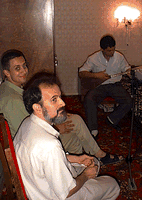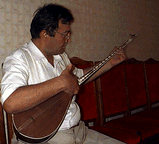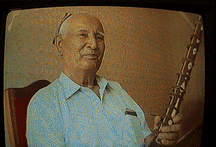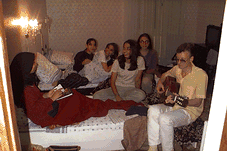The BBC Musical Nomad
Posts Tagged Abdurahim Hamidov
Day 8 – The Land of Lutes
Posted by Musical Nomad in Daily Blog on August 5, 1997
The Land of Lutes
Every journey has it’s trials and today we’re having our fair share. Last night I was struck down with a bug, without going into graphic detail. I am now laid up in bed unable to be of much use to anyone. As if this were not enough Gary and Kathrin are at various Government Departments wading through acres of red tape. The officials in Tashkent are very suspicious about our new imported Satellite transmitter – are we really James Bondski? Only a letter from the Minister of Foreign Affairs can convince them to release this much needed lifeline. Without this we cannot continue our dialogue or bring you the exciting music we have been hearing. We hope we will soon be ‘on-line’ eager to reply to your e-mails. Only Paul is left back at the ranch, Dat machine in one hand, camera in the other. He loves it really! While I catch up on much needed sleep I leave you in his capable hands. I know he’s dying to tell you about lutes.
 As one of the guitarists and sitarist in our team I’m fascinated by the ‘lutes’ we encounter. I’ve just been lent a dutar by Abdurahim Hamidov. Living with the dutar, having it around my room playing it, I feel invited in to a sort of magic. It has made me incredibly aware of the close relationship between all these Central Asian instruments and most of the world’s ‘lutes’. The two-stringed dombras and dutars have all the latent characteristics of the guitar, the Oud and the sitar. The tuning in fourths (and fifths), the tendency to play parallel patterns up and down the fingerboard – the modal scales are all common to these more familiar instruments. The rasguedo of the dutar is almost “flamenco” in character. The vibrato and portamento techniques are reminiscent of the classical Oud of Arabia.
As one of the guitarists and sitarist in our team I’m fascinated by the ‘lutes’ we encounter. I’ve just been lent a dutar by Abdurahim Hamidov. Living with the dutar, having it around my room playing it, I feel invited in to a sort of magic. It has made me incredibly aware of the close relationship between all these Central Asian instruments and most of the world’s ‘lutes’. The two-stringed dombras and dutars have all the latent characteristics of the guitar, the Oud and the sitar. The tuning in fourths (and fifths), the tendency to play parallel patterns up and down the fingerboard – the modal scales are all common to these more familiar instruments. The rasguedo of the dutar is almost “flamenco” in character. The vibrato and portamento techniques are reminiscent of the classical Oud of Arabia.
If the lute began in Central Asia as many scholars believe, what fascinating journeys it has made – into China, India, Arabia and Europe – taking new names and new shapes but retaining its Central Asian roots.
 Abdurahim Hamidov who I met today is an incredible virtuoso on the dutar. He also knows many of the other lutes of the area and explained their relationship. According to Abdurahim the dombra which we heard a lot of in Kazakstan is primarily a folk instrument. Though if you refer back to Day 4, you can hear that Aygul Ulkenbaeva is now taking the dombra to a more sophisticated level.Abdurahim regards his dutar as a classical instrument, especially in the context of the Shash maqam though he often performs solo as well as accompanying singers.
Abdurahim Hamidov who I met today is an incredible virtuoso on the dutar. He also knows many of the other lutes of the area and explained their relationship. According to Abdurahim the dombra which we heard a lot of in Kazakstan is primarily a folk instrument. Though if you refer back to Day 4, you can hear that Aygul Ulkenbaeva is now taking the dombra to a more sophisticated level.Abdurahim regards his dutar as a classical instrument, especially in the context of the Shash maqam though he often performs solo as well as accompanying singers.
Physically, the dutar is more sophisticated and highly decorated with beautifully made silk strings instead of the factory produced nylon strings of the dombra. Curiously his dutar retains its modal scale – it has not been ‘improved’ to a fully chromatic version (yet!). Abdurahim also asserts that his dutar has different tunings; in fourths, fifths and unison whereas he alleges the dombra doesn’t (I’m not convinced).
I encountered another fascinating lute yesterday, the Kashgar rubab played by Munajat’s teacher Shavkat Mirzaev. This is a five string lute with four metal and one silk string – an unusual mix. The silk string is very thick and provides a rich bass. The four metal strings are arranged in two pairs and are used for melody. The rubab has a haunting sound enhanced by its parchment sounding board and the harmonic richness of those pairs of metal strings. There are superficial relationships here to the saz of Turkey and the bouzouki of Greece. Earlier, in a taxi I heard the local version of Greek popular music or Rembetika – it’s a strange and wonderful world.
 Wow, another lute – today we met Pattahon Mamadaliev, a fantastic 70 year old guy. He sings with a consuming passion and accompanies himself on the tanbur. It has four bronze strings. In India bronze is a sacred metal, I must check out its significance here. The tanbur has very thick gut frets to enable a deep vibrato, it’s made from mulberry and apricot. Pattahon possesses an intensity of performance and a sincere unmannered humility. I played some Spanish lute music for the musicians, Pattahon and Abdurahim. Abdurahim said he understood this 15th century lute music perfectly, which is interesting. This music is very polyphonic ‘in many parts’ as opposed to most Central Asian music which is often monodic. They also enjoyed a bit of pseudo-Flamenco – this is also interesting as Pattahon’s passion and style is reminiscent of Canto Joto from Andalucia in Southern Spain, a deep form of flamenco. Somebody must have told the lute to “go forth and multiply “- I’m ever more convinced that the lute family originated here as most scholars assert.
Wow, another lute – today we met Pattahon Mamadaliev, a fantastic 70 year old guy. He sings with a consuming passion and accompanies himself on the tanbur. It has four bronze strings. In India bronze is a sacred metal, I must check out its significance here. The tanbur has very thick gut frets to enable a deep vibrato, it’s made from mulberry and apricot. Pattahon possesses an intensity of performance and a sincere unmannered humility. I played some Spanish lute music for the musicians, Pattahon and Abdurahim. Abdurahim said he understood this 15th century lute music perfectly, which is interesting. This music is very polyphonic ‘in many parts’ as opposed to most Central Asian music which is often monodic. They also enjoyed a bit of pseudo-Flamenco – this is also interesting as Pattahon’s passion and style is reminiscent of Canto Joto from Andalucia in Southern Spain, a deep form of flamenco. Somebody must have told the lute to “go forth and multiply “- I’m ever more convinced that the lute family originated here as most scholars assert.
I’m currently in the lap of luxury – our little guest house even has a tiny swimming pool. I banged my head trying it out – perhaps it will knock some sense into me? The food here is the best so far in Central Asia – delicious Vegetarian stuff – not that common in the land of the rising Kebab.
I got caught last night serenading five Muslim girls in their bedroom – their father just laughed and went to bed – not the expected reaction. The girls enjoyed a Bo-Diddly song but thought Shash maqam was ‘pretty cool’. They are on holiday from Chicago, so that probably explains their frankly modern behaviour. Jan still has the “montezumas revenge”, so retires early. Kathrin and Gary are simply exhausted, endless wrangling and still we can’t get our satellite out of customs.
got caught last night serenading five Muslim girls in their bedroom – their father just laughed and went to bed – not the expected reaction. The girls enjoyed a Bo-Diddly song but thought Shash maqam was ‘pretty cool’. They are on holiday from Chicago, so that probably explains their frankly modern behaviour. Jan still has the “montezumas revenge”, so retires early. Kathrin and Gary are simply exhausted, endless wrangling and still we can’t get our satellite out of customs.
Tomorrow, who knows?
Abdurahim Hamidov, Arabia, Central Asia, Chicago, China, Europe, food, GARY, Greece, India, James Bondski, KATHRIN, Kazakstan, metal strings, Minister of Foreign, Pattahon Mamadaliev, sacred metal, Shavkat Mirzaev, Spain, swimming, Tashkent, teacher, Turkey
Live Daily Journal
- Day 0 - Through the telling of stories we try and make sense of our world
- Day 1 - We disembark with a sense of foreboding
- Day 2 - I didn't realise it would happen on the second day!
- Day 3 - Communication happens in many ways
- Day 4 - Let the music and musical instruments be the bridge between the peoples of the World
- Day 5 - When I play it seems that I understand the Shamanic tradition
- Day 6 - On the aircraft it's bedlam and as people push and fight for the seats
- Day 7 - "My soul was taking flight" Navai
- Day 8 - The Land of Lutes
- Day 9 - Red Tape Hell, Musical Heaven
- Day 10 - Seven Heavens Beneath a Waterfall
- Day 11 - A great deal of what we see depends on what we are looking for
- Day 12 - Bukhara - holy city. 2500 years of written history, 6000 years of mythology
- Day 13 - a satellite beams from Bukhara
- Day 14 - To succeed this project must be interactive
- Day 15 - Bukhara to Baysun, into the mountains at last
- Day 16 - Let us hear your voice
- Day 17 - Ten Second Tornadoes on the Road to Samarkand
- Day 18 - Market Shares in Aladdin's Cave
- Day 19 - Culture is a Living Thing
- Day 20 - If I ask for paradise, kill me!
- Day 21 - the person who arrives is not the one who left
- Day 22 - Angels of Fire, Tashkent to Kokand
- Day 23 - Everyone's free in Uzbekistan to live however they want
- Day 24 - The Elusive Shaman
- Day 25 - The Pulse of the Maternal Heart
- Day 26 - Vultures Circle Looking for Musical Nomads?
- Day 27 - Two Weddings and a Satellite
- Day 28 - Even the Wind Sings
- Day 29 - Home Cooking on the Road to Issyk-Kul
- Day 30 - we try and make sense of our world Pt II
- Day 31 - When we travel there is no past or future. We engage with the moment
- Day 32 - Where there is spirit there is usually music
- Day 33 - another half-ready kobuz nestled like a hibernating wild animal
- Day 34 - Take the first left on the A351
- Day 35 - as words fail Diana dies on the Kazak Steppe
- Day 36 - Mad ride to music lesson
- Day 37 - Timeless songs for the next generation
- Day 38 - This journey is only the beginning
- Day 39 - Home again
- Day 40 - This journey is only the beginning
Archive
- September 1997 (6)
- August 1997 (31)
- July 1997 (4)